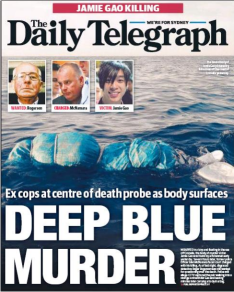Press Council rejects complaints over Daily Telegraph Jamie Gao front page
 A complaint over The Daily Telegraph’s front page which showed murdered teenager Jamie Gao’s body wrapped in a tarpaulin floating in the ocean has been dismissed by the Australian Press Council (APC).
A complaint over The Daily Telegraph’s front page which showed murdered teenager Jamie Gao’s body wrapped in a tarpaulin floating in the ocean has been dismissed by the Australian Press Council (APC).
The complaint centred around the fact a foot could be seen protruding from the end of the tarpaulin in the feature image on the front page, published on May 27, which carried the headline “Deep blue murder: Ex cops at centre of death probe as body surfaces”.
A ruling issued by the APC today noted while the front page had the potential to cause “great offence” there were public interest arguments in highlighting the risks of drug dealing, that outweighed the potential for offence.
“The Council considers in this case that publishing the photograph did not breach its Standards, even though it was very prominent on the front page. This is mainly because there was a very strong justification in the public interest and also because the foot was not shown in graphic detail,” said the APC ruling.
Defending its decision to publish the image the paper claimed it was justifiable on public interest grounds, citing campaigns over many years against drug and gun crimes, adding that despite the risk of offending some readers publishing the photograph showed the potential consequences from involvement in drug-related crime.
The APC ruling found: “The Council considers that, especially by showing the foot, the photograph was likely to cause great offence to a significant number of people, including those who merely saw it on a newsstand. A substantial number of people who saw it are likely to have known the student.
“On the other hand, the Council believes that powerful exposure in this way of the risks of becoming involved in drug deals can be of substantial importance in the public interest. This effect would have been less powerful if the foot had not been shown to establish that the bag contained a body.”
The Council’s relevant Standard of Practice requires that any reasonably likely offence to sensibilities should be weighed against the importance of publishing the photograph in the public interest.
The Telegraph was also not the only newspaper to run images of Gao’s body with the Sydney Morning Herald also choosing to run the image less prominently than the News Corp title did.
“The Council’s principal concern was that the photograph was shown on the front page and was very large,” the APC noted.
“Placing it on a very prominent inner page, with a clear warning on the front page, could have substantially reduced the risk of offence while not greatly reducing its effectiveness in raising awareness of the drug trade’s dangers. In some instances, therefore, placement of photographs on the front page may breach the Council’s Standards even though they would have been acceptable inside the newspaper.”
Nic Christensen


There’s outrage when a billboard shows a dead horse yet a picture of a dead person is dismissed?
This is appalling. Being one of those people that knew Jamie, this image made me physically ill when it came out and definitely made the grieving process a lot more grueling. I can only imagine the damage it did to his mother. It’s not about how the foot isn’t graphic, it’s about the fact that we knew his body was in there, that we could see they were the shoes that he always wore.
It’s downright immoral and unethical to take the death of an individual and use it as a public service announcement, warning people against drugs. This is just the APC allowing The Daily Telegraph to picket at someone’s funeral like the Westboro Baptist Church.
You try explaining to a 5 year old the front page of your rag. Whats the point of TV censoring again?